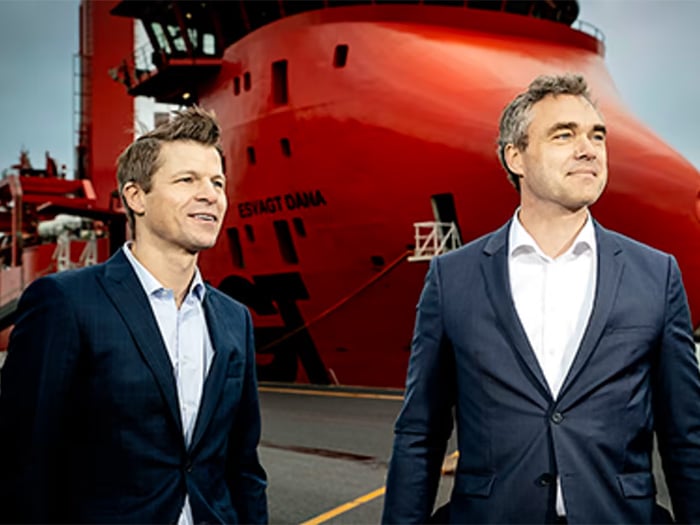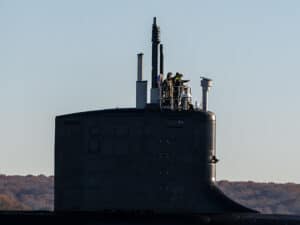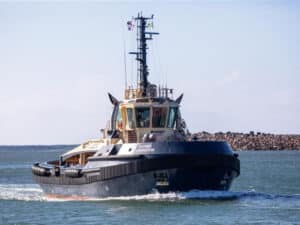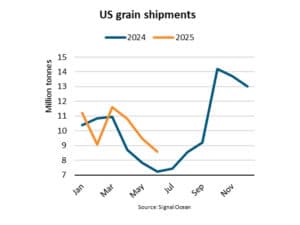
Ørsted and Esvagt sign agreement on the world’s first green fuel SOV
Written by Nick Blenkey
Søren Karas, chief strategy and commercial officer, Esvagt (left)and Lars Høy Jørgensen, head of operations logistics, Ørsted
Two Danish headquartered offshore wind industry leaders — Ørsted and service and support vessel operator Esvagt — are to invest in the world’s first service operation vessel (SOV) able to operate on green fuels. The SOV will be powered by batteries and dual fuel engines and will be capable of sailing on renewable e-methanol, produced from wind energy and biogenic carbon. The resulting yearly emission reduction will be some 4,500 tonnes of CO2.
By ordering the new SOV, Ørsted and Esvagt say they are showing their commitment to a green maritime sector and helping create the needed demand to accelerate to cost reductions of green fuels for the maritime industry. The investment decision, they say, also sends a clear signal that the future for both service and installation vessels is green.
Ørsted intends to supply the e-methanol for the green-fueled SOV. Over the past two years, Ørsted has built up a diverse portfolio of green fuel projects, three of which focus on producing e-methanol for maritime transport. The portfolio includes a newly announced project on the U.S. Gulf Coast, which will supply 300,000 tonnes of e-methanol for Maersk’s fleet of zero-emissions vessels. Other projects include “Green Fuels for Denmark” and FlagshipONE in Sweden, both of which can supply around 50,000 tonnes of e-methanol for shipping in 2024-2025.
An offshore wind farm already has 99% lower emissions than a coal fired power station, seen over the entire lifetime of the asset, including production, construction, and installation. Today’s announcement by Esvagt and Ørsted marks a step on the way towards mitigating the remaining emissions. The decision to invest in the new green fuel SOV also supports Ørsted’s target of becoming carbon-neutral in its energy generation and its own operations by 2025.
BUILD STARTS THIS YEAR
Esvagt will start building the vessel in the second quarter of 2022. Once commissioned by the end of 2024, the SOV will start servicing the world’s largest offshore wind farm, Hornsea 2, off the U.K.’s east coast.
The green fueled SOV will incorporate the newest technologies. and the highly-trained Esvagt crew will be enabled by digital tools.
The SOV is designed for comfort and high workability, providing a highly efficient workspace and safe transfer of technicians at the windfarm via a motion-compensated gangway and transfer boats as well as a crane to lift heavy spare parts. As a floating home, it also offers recreational activities for the on-board crew and technicians, including fitness facilities, a game room, a cinema, and individual accommodations. It will be equipped with a helipad for fast access and transfers from shore.
Particulars of green fuel SOV
- Length overall: 93.00 meters
- Breadth: 19.60 meters
- Maximum draft: 6.50 meters
- Speed approx. 14 knots
- Accommodations 124 persons
- Helideck (D=18 meters/ 9 tonnes)
“As the world leader in offshore wind, it’s natural for Ørsted to take the lead in driving out fossil fuels from the industry,” said Mark Porter, head of offshore operations at Ørsted, says:. We’ve set clear targets and a clear direction towards net-zero emissions, and this new methanol-powered SOV is a tangible proof of our clear commitment to realise these targets. The agreement with ESVAGT checks many boxes for us, as it both helps decarbonise our offshore operations while also demonstrating our strong belief that green fuels based on renewable energy is the most viable solution to create a green maritime sector.”
Søren Karas, chief strategy and commercial officer at Esvagt, says: “This is an important milestone with real meaningful impact on the green transition. Ørsted and Esvagt share an ambition for a sustainable future, and as an industry leader we’re committed to taking the lead in decarbonizing the maritime industry. We’re delighted and proud to be able to take this bold step together with Ørsted towards making offshore wind marine solutions fossil free with an innovative new solution.”
Ørsted has implemented a systematic approach for reducing emissions from its offshore logistics through efficiency initiatives, including route optimizations and sailing at fuel-saving speeds. Ørsted has also implemented light hybrid crew transfer vessels for increased fuel efficiency.
Søren Karas, chief strategy and commercial officer, Esvagt (left)and Lars Høy Jørgensen, head of operations logistics, Ørsted




